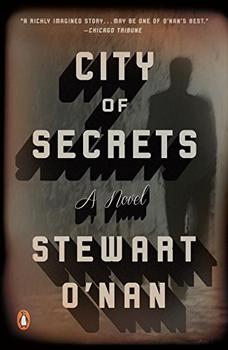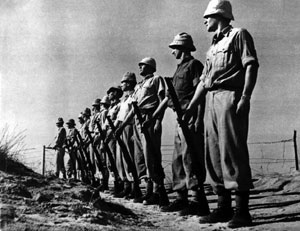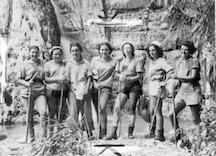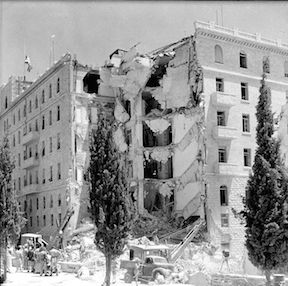Summary | Excerpt | Reviews | Beyond the Book | Read-Alikes | Genres & Themes | Author Bio

Critics' Opinion:
Readers' Opinion:
First Published:
Apr 2016, 208 pages
Paperback:
Apr 2017, 208 pages
 Book Reviewed by:
Book Reviewed by:
Naomi Benaron
Buy This Book
This article relates to City of Secrets
 Stewart O'Nan's City of Secrets begins in Mandatory Palestine when there were three main organizations in the Jewish resistance: the Haganah, Irgun, and Lohamei Herut Israel, commonly known as the Stern Gang. The first organization was the Haganah, which means "defense" in Hebrew. It began in 1920 in response to Arab violence against the yishuv, the body of Jewish residents in the territory of Palestine. Zionist immigration to Palestine had been increasing since the Balfour Declaration, a "declaration of sympathy with Jewish Zionist aspirations" was signed in the UK in 1917. For the most part, Arabs and Jews coexisted in relative peace, but the large waves of Jewish immigrants alarmed a portion of the Arab population, resulting in the Arab riots of the 1920s. During the riots, British forces did not intervene. This reinforced the belief that the yishuv could not depend on them, and in June 1920, the Haganah became the official organization charged with the defense of the Jewish people in Palestine.
Stewart O'Nan's City of Secrets begins in Mandatory Palestine when there were three main organizations in the Jewish resistance: the Haganah, Irgun, and Lohamei Herut Israel, commonly known as the Stern Gang. The first organization was the Haganah, which means "defense" in Hebrew. It began in 1920 in response to Arab violence against the yishuv, the body of Jewish residents in the territory of Palestine. Zionist immigration to Palestine had been increasing since the Balfour Declaration, a "declaration of sympathy with Jewish Zionist aspirations" was signed in the UK in 1917. For the most part, Arabs and Jews coexisted in relative peace, but the large waves of Jewish immigrants alarmed a portion of the Arab population, resulting in the Arab riots of the 1920s. During the riots, British forces did not intervene. This reinforced the belief that the yishuv could not depend on them, and in June 1920, the Haganah became the official organization charged with the defense of the Jewish people in Palestine.
The organization remained a loosely knit coalition of forces, poorly armed and for the most part poorly trained, until the Arab Riots of 1929, where a week of violence throughout Mandatory Palestine left hundreds dead and many more wounded. During the violence, the British did nothing to curtail the Arab attackers or come to the aid of the Jews who were under attack. These events served to change the focus and organization of Haganah. It then became a single underground organization made up of nearly all the youth and young adults of the kibbutzim and outlying settlements as well as many inside the cities. Members underwent rigorous military training, and a central arms depot was established for weapons that came in from Europe. As well, factories were set up in cellars to manufacture arms and ammunition. Although the British did not officially recognize the organization, there was a degree of tacit cooperation in the establishment of defensive militia to protect the settlements.
In 1930 or '31, a splinter group calling themselves Irgun broke away from the Haganah. Where the Haganah believed in a policy of restraint, Irgun believed in violent reprisal. A series of terrorist attacks against Arab civilians led to condemnation by the Jewish Agency, the administrative arm of the yishuv, and arrests by the British. With publication of the British White Paper of 1939, which severely restricted and then eliminated Jewish immigration to Palestine, Irgun redirected their terrorist tactics against the British.
 In 1941, with fear growing of a German invasion, the Haganah established the Palmach, or Pelugot Hamahatz, Hebrew for "strike force". These were highly trained commando units based on kibbutzim and ascribing to the agrarian, socialist ideology. In cooperation with the British, 32 Palmach paratroopers were dropped behind enemy lines in Eastern Europe to find resistance fighters and gather information. Among them was Havivah Reik, a Slovakian born poet who was captured by the Germans in Hungary and, after a long imprisonment, executed.
In 1941, with fear growing of a German invasion, the Haganah established the Palmach, or Pelugot Hamahatz, Hebrew for "strike force". These were highly trained commando units based on kibbutzim and ascribing to the agrarian, socialist ideology. In cooperation with the British, 32 Palmach paratroopers were dropped behind enemy lines in Eastern Europe to find resistance fighters and gather information. Among them was Havivah Reik, a Slovakian born poet who was captured by the Germans in Hungary and, after a long imprisonment, executed.
Irgun and Haganah joined forces again with the outbreak of WWII, both groups cooperating with the British against the Axis forces. This led to a second split in Jewish defense groups when Lohamei Herut Israel or LEHI (Fighters for the Freedom of Israel), under the leadership of Avraham Stern, refused to end its fight with the British and broke away from Irgun. Twice, they attempted to form an alliance with Italy and Germany and then declared their support for Stalin and Bolshevik Russia. They were the most extreme of the three groups, assassinating Lord Moyne, the British Minister for Middle East Affairs, in 1944.
 When it became clear that the end of WWII would not bring an end to the anti-immigration policy of the British, the three groups again joined forces in the Jewish Resistance Movement. Their first joint operation was the October 1945 attack on the Atlit internment camp, liberating the 208 "illegal immigrants" (most smuggled in from Europe by resistance groups) being held there. Other joint actions included the "Night of Trains" on November 1 1945, in which rail lines were destroyed at 153 spots and the main rail station was attacked; the June 17 1946 destruction of 10 bridges linking Palestine to its Arab neighbors; the kidnapping of British soldiers in retaliation for the detention of 2,700 Jews and the arrests of members of the Jewish agency; and, most significant for the course of history, the July 22 1946 bombing of the British military and administrative offices in the south wing of the King David Hotel.
When it became clear that the end of WWII would not bring an end to the anti-immigration policy of the British, the three groups again joined forces in the Jewish Resistance Movement. Their first joint operation was the October 1945 attack on the Atlit internment camp, liberating the 208 "illegal immigrants" (most smuggled in from Europe by resistance groups) being held there. Other joint actions included the "Night of Trains" on November 1 1945, in which rail lines were destroyed at 153 spots and the main rail station was attacked; the June 17 1946 destruction of 10 bridges linking Palestine to its Arab neighbors; the kidnapping of British soldiers in retaliation for the detention of 2,700 Jews and the arrests of members of the Jewish agency; and, most significant for the course of history, the July 22 1946 bombing of the British military and administrative offices in the south wing of the King David Hotel.
Following the bombing, in which 91 people were killed, Ben-Gurion, who was at that time head of the Jewish Agency, severed his relationship with Irgun and LEHI. With independence in 1948, the government of Israel formally disbanded LEHI, and the Haganah became the Israeli Defense Force, the army of the State of Israel. Menachem Begin, head of Irgun since 1943, also disbanded the organization of Irgun with Israel's declaration of independence, and Irgun fighters were absorbed into the IDF.
Haganah members in training, 1947
Women of Palmach, 1942
The King David Hotel after the bombing, photo from The Palestine Post, 1946
Filed under People, Eras & Events
![]() This "beyond the book article" relates to City of Secrets. It originally ran in May 2016 and has been updated for the
April 2017 paperback edition.
Go to magazine.
This "beyond the book article" relates to City of Secrets. It originally ran in May 2016 and has been updated for the
April 2017 paperback edition.
Go to magazine.





The Flower Sisters
by Michelle Collins Anderson
From the new Fannie Flagg of the Ozarks, a richly-woven story of family, forgiveness, and reinvention.

The House on Biscayne Bay
by Chanel Cleeton
As death stalks a gothic mansion in Miami, the lives of two women intertwine as the past and present collide.

The Funeral Cryer by Wenyan Lu
Debut novelist Wenyan Lu brings us this witty yet profound story about one woman's midlife reawakening in contemporary rural China.
Your guide toexceptional books
BookBrowse seeks out and recommends the best in contemporary fiction and nonfiction—books that not only engage and entertain but also deepen our understanding of ourselves and the world around us.